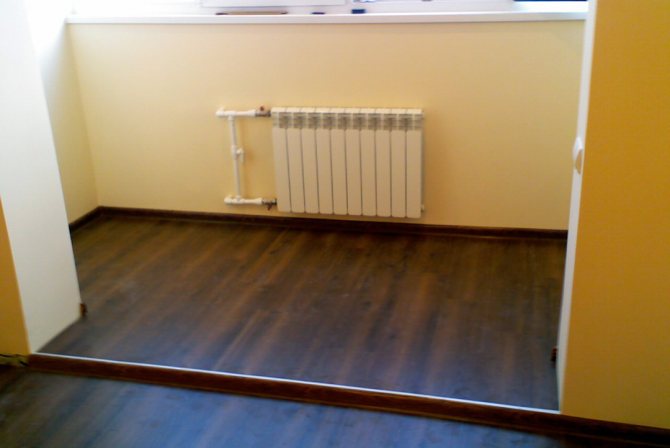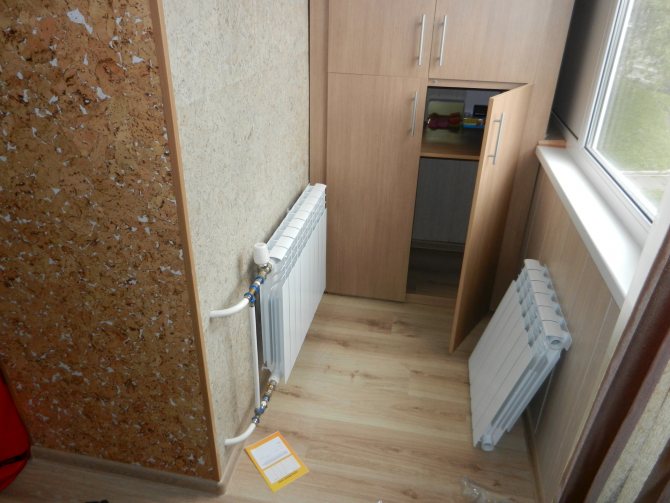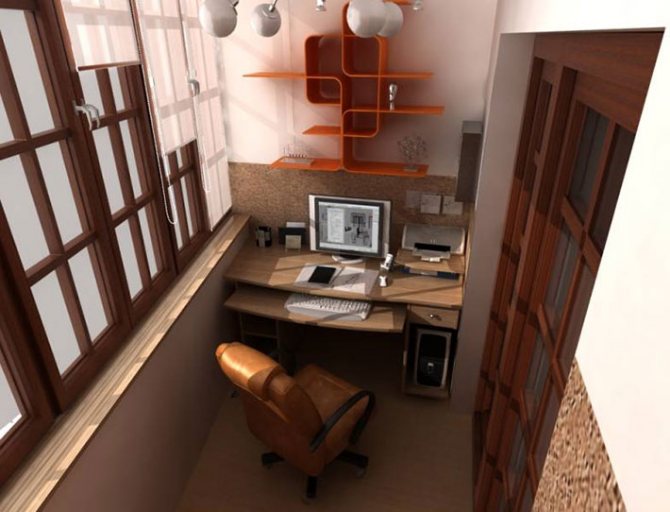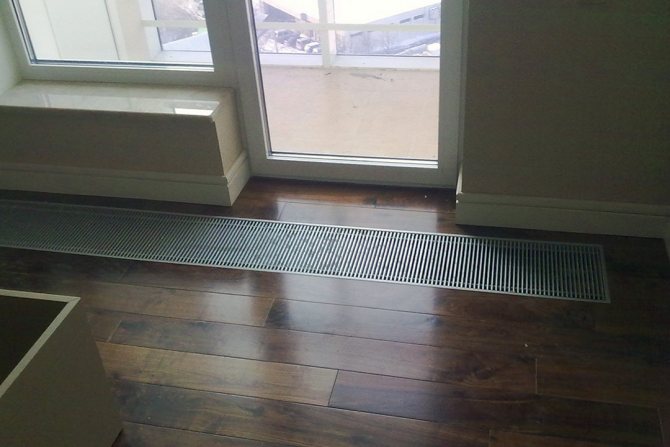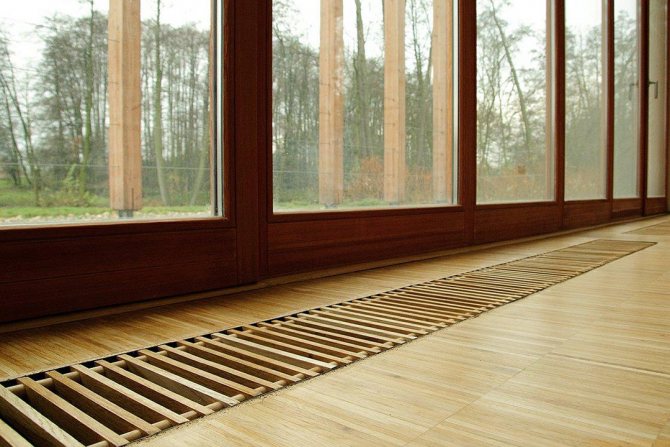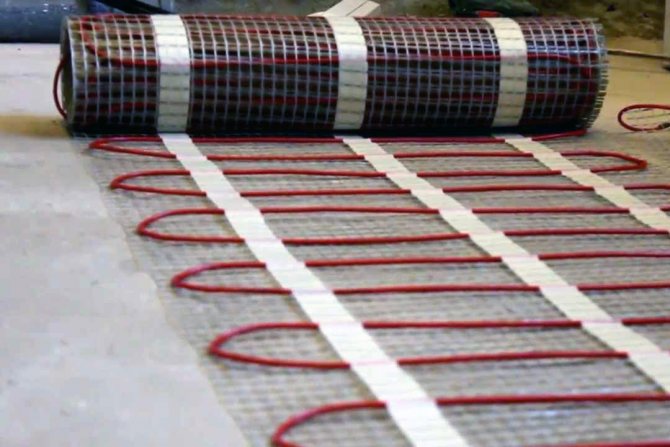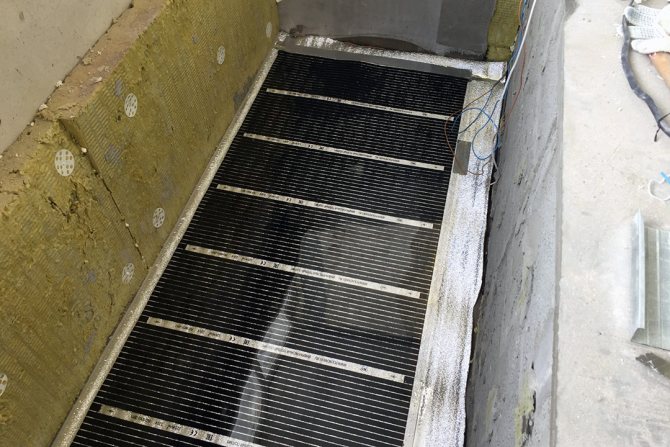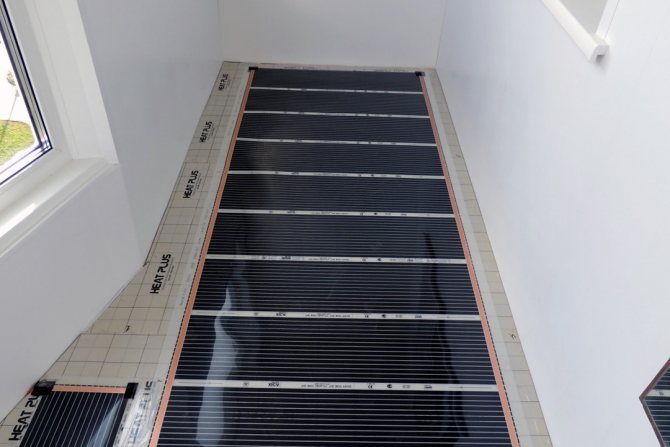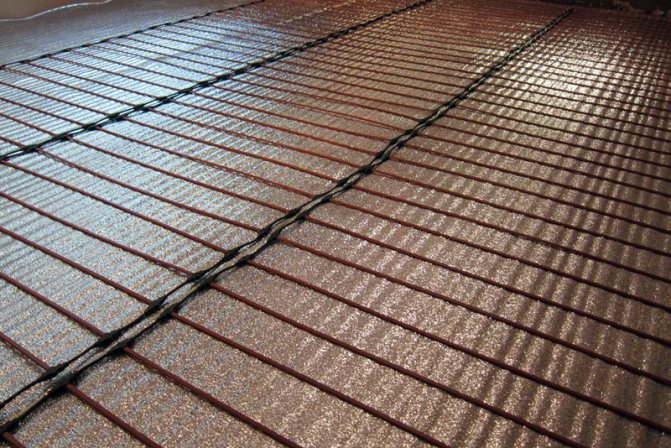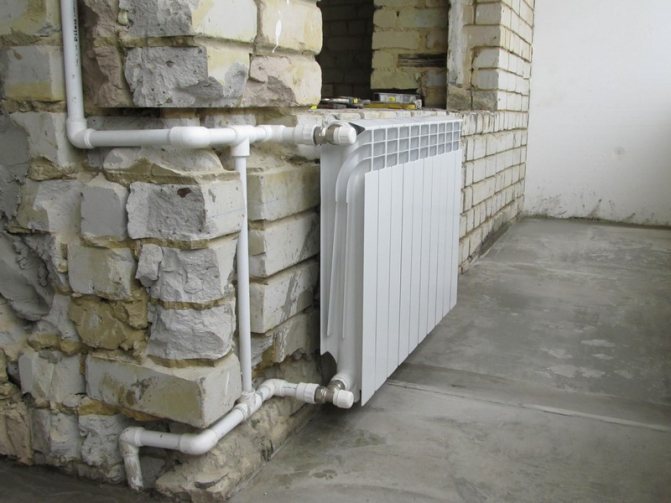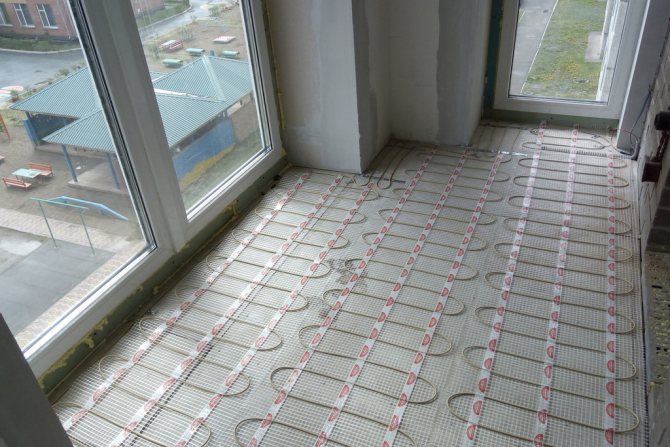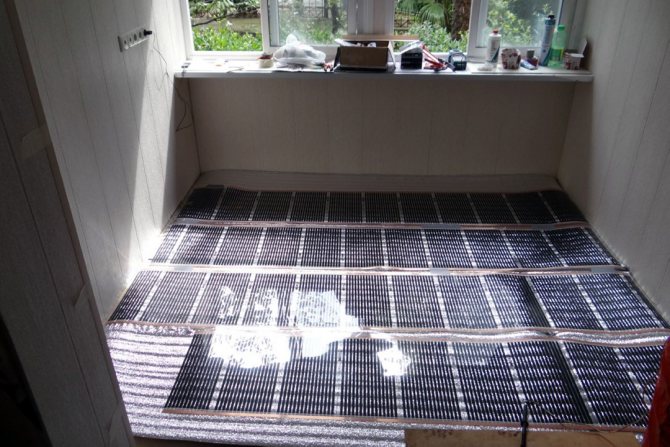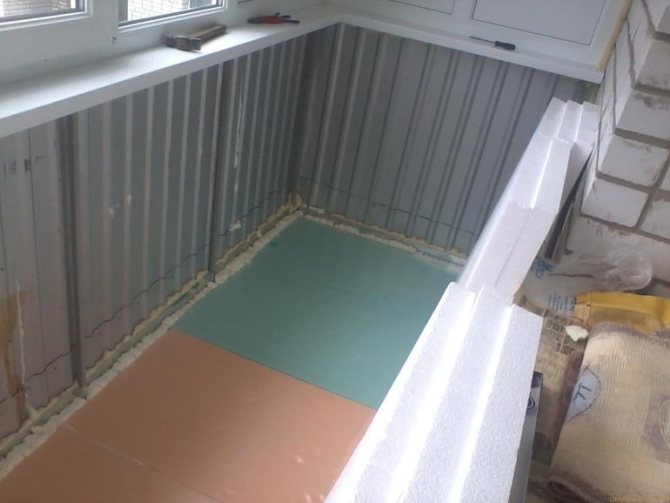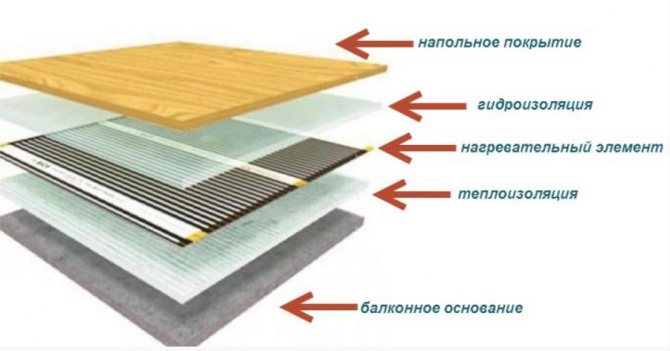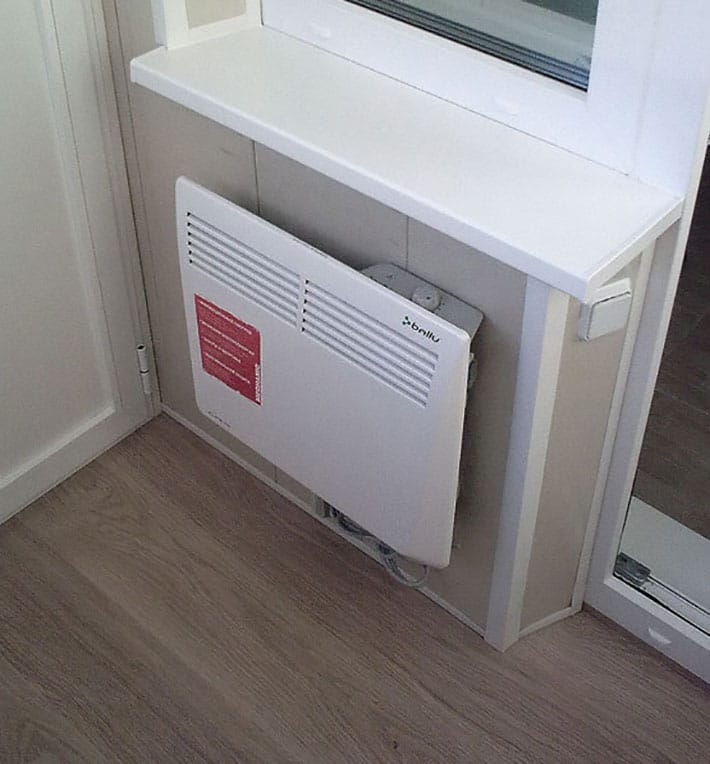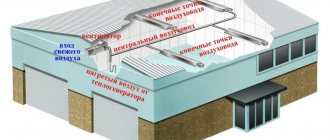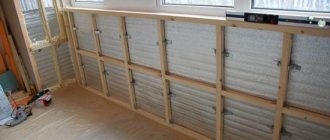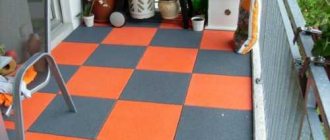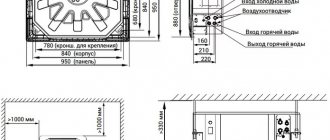In many apartments, a balcony or loggia serves as a dump for all garbage, cans of pickles, and sports equipment. This is due to the fact that it is simply impossible to be there in winter. If you save on the insulation of the balcony, then in the cold season the temperature on it can drop below 0 degrees.
Making a full-fledged living space out of a loggia does not cost a lot of money or effort. For this, it is not necessary to carry out a full-fledged repair. But if possible, you need to think about heating the balcony or loggia already at the construction stage.
Insulation of the loggia during the construction phase
The tips in this section are suitable for "bare" balconies and loggias. The main difference between these two rooms is that the balcony protrudes from the facade of the house, and the loggia is separated from the main room by a wall. Read more in the article "loggia and balcony, what is the difference".
The first thing you should decide is whether you are ready to start insulation outside. This may require special equipment if you live above the 1st floor. Double-sided insulation is necessary for large rooms.
Seal all cracks with sealant (small) or polyurethane foam (large). Through them, heat leaves the fastest. Level all walls with putty, cement mortar. This increases the efficiency of the thermal insulation.

Pay particular attention to moisture insulation. Dampness attracts cold. Treat the internal and external walls with a moisture-repellent mortar before installing the heat-insulating panels.
Getting permission
BTI permission is needed to move the radiator or connect another heating device. All of the above is absolutely true and, most likely, such permission will not be given for the reasons already mentioned.
But there are several options in which a positive solution to the issue is possible:
- Autonomous heating of the house. If there is a separate boiler house that serves a quarter or specifically your apartment building, BTI can issue a permit. Since in this case it is enough to simply carry out a recalculation and it is possible that such changes will not cause large disturbances in the hydraulic balance of the system.
- Independent connection to centralized heating. With an independent connection to district heating, the building heating and heating plant are not hydraulically connected. In this case, heat exchange takes place in a recuperative heat exchanger, which is installed in the basement of an apartment building. Since the hydraulic system in this case is much less branched in comparison with the dependent connection, deviations in the operation of the system are easy to predict and eliminate.
- Installation of a shut-off and control valve in the basement instead of the throttling washer. A positive decision in this case is much less likely, but still possible. In this case, it is easier to link the new hydraulic system with neighboring houses and thus eliminate the extraneous noise that appears in the neighbors' heaters or risers. The throttling washer will have to be changed, and for this you need to recalculate and drain the heating system. The check valve is easy to move.
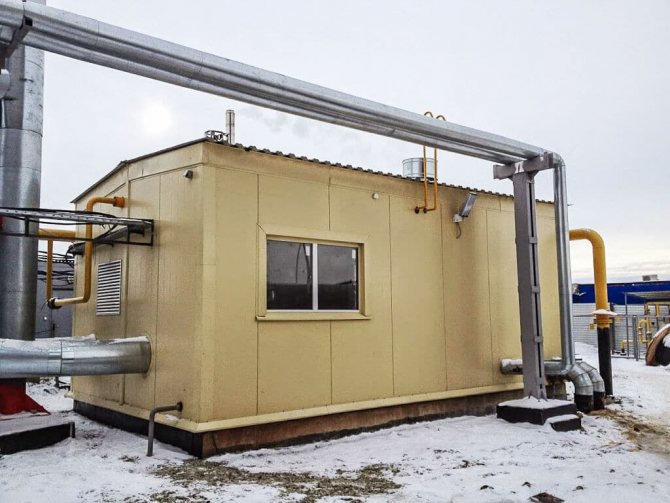

Heating on the loggia is possible with a separate boiler room, which serves only your home
Insulating materials
The following types of heaters are presented on the market:
- expanded clay;
- mineral wool;
- expanded polystyrene;
- polyurethane foam;
- penofol.
Choosing the best material is easier than it sounds.
Expanded clay
This is the cheapest material. Does not hold its shape, readily absorbs moisture. Durable, resistant to fire, mold, mildew.It is used to insulate the floor on the balcony when they want to save money.
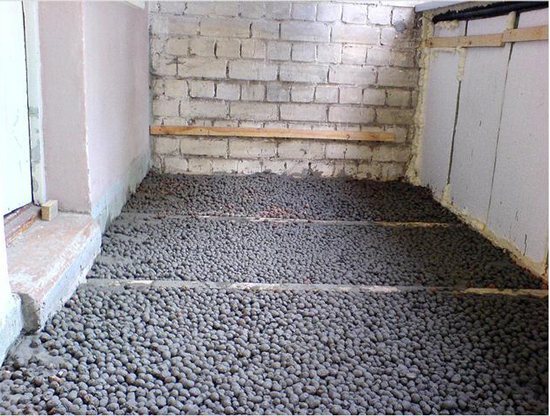

Insulation of the floor on the loggia with expanded clay
Mineral wool
Material of the middle price category. Slabs made of it are very wide, so they are not suitable for small spaces. Moisture penetration will impair the insulation properties. Mineral wool is environmentally friendly, fire-resistant, creates additional sound insulation.


Thermal insulation of a balcony with mineral wool
Expanded polystyrene
Expensive insulation, devoid of any flaws. Plates are easily attached to any surface using self-tapping screws. The best option for any room.
Polyurethane foam
Liquid insulation. Easily fills any cracks, cavities. Installation requires special equipment. Dismantling presents some difficulties.
Penofol
Auxiliary thin heat and waterproofing agent. It is used together with expanded polystyrene, mineral wool to create an additional air gap.
After you have chosen a heat insulator, proceed with the installation. First, all walls, floor, ceiling must be covered with a layer of waterproofing made of polyethylene or penofol, and the joints between the sheets must be glued with tape.
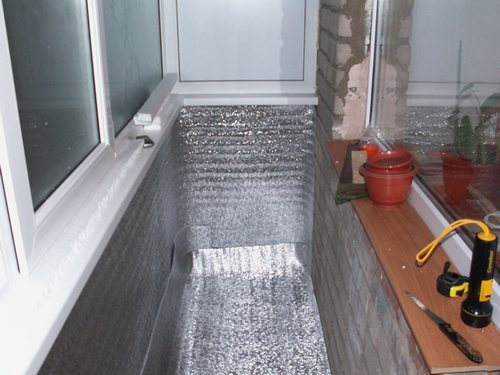

Insulation of the balcony with penofol
Then a metal or wooden frame is erected (for more details, see the article “balcony lathing”), into which the insulation will then be laid. The distance between it and the surfaces must be sealed with polyurethane foam. Next, the insulating plates are laid tightly. There should be no gap between them and the frame, otherwise all the work will go to waste.
On top of this structure, a rough covering is made of chipboard, plywood. You can install a warm floor on a loggia on it. Then finishing work is carried out.
Electric underfloor heating
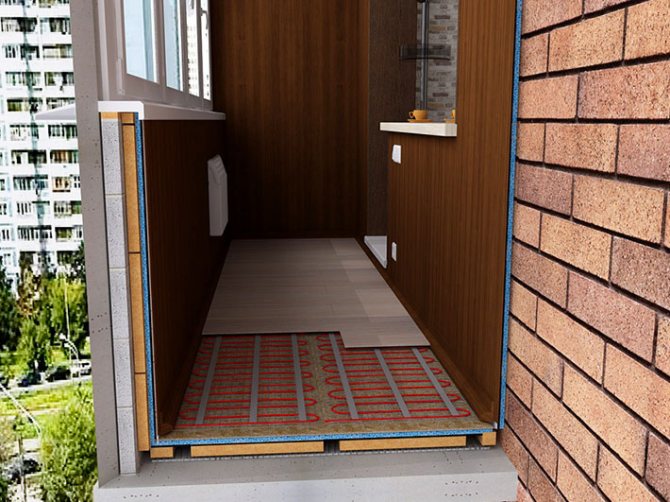

Photo 8. Electric warm floor on the balcony
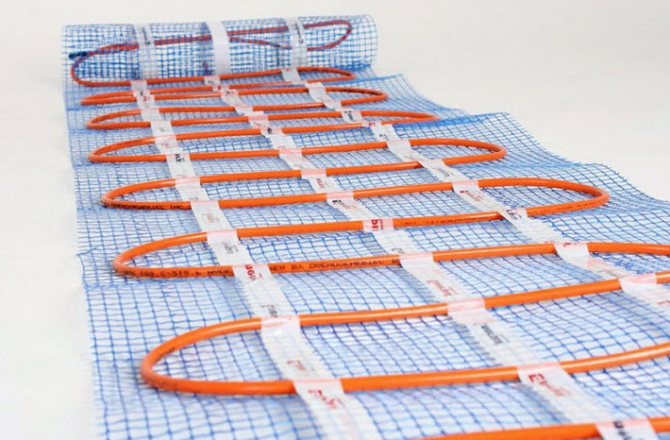

The main role in the form of a heater is played by an electric cable. Before making electric heating in the room, you need to prepare the base of the floor on the loggia, remove all the old coating, clean the concrete to a smooth state, level out all the irregularities. A cement-sand screed must be made on the prepared base. Its height must exceed 3 cm.
The next layer is a layer of insulation. Here it is necessary to take into account the possibility of condensation, that is, water. The temperature difference between the walls of the floor, the external and internal environment leads to uneven distribution of heat, the formation of cold bridges, as a result of condensation and dampness. To avoid this, they lay a heater with a vapor barrier. Mineral wool is not recommended here. Refractory insulation, such as polystyrene, is placed on the prepared concrete floor. A vapor barrier in the form of polyethylene is laid on top of the insulation, fixed with construction tape. Actually, the very layer of the cable, which is fixed with an additional tie. After that, the entire system should dry thoroughly for several weeks, and only then can you proceed to laying the finishing coating.
The finishing step is to lay the decorative surface. It is not recommended to make a wooden covering, it significantly reduces the efficiency of any heating floor. It is acceptable to use tile or ceramic tiles with good thermal conductivity.
Do-it-yourself balcony insulation
If you do not have time to do a full-fledged repair of the balcony with your own hands, use some folk methods of warming the loggia. The temperature can rise by several degrees. Remember this is a temporary measure. Such "tricks" will not be able to replace full-fledged thermal insulation.
Walk around the loggia with a candle or lighter. This will help determine from which joints, cracks are blowing. Cover them with putty. Draft is the worst enemy of heat.
Build insulating panels with unnecessary pieces of foam. This material does not conduct heat well.
Such impromptu warming can be done in a few hours, but even this trifle lowers the chance of catching a cold from the cold coming from the loggia.
Central heating batteries
Previously, it was possible to bring the central heating battery to the balcony without any problems. It was not forbidden to do the editing yourself. But now such actions are an administrative article.
The government decided to limit the ability of residents of apartment buildings to change the layout of heating systems. This was done for security reasons. The battery on the loggia can freeze and burst.


Having an experienced lawyer, observing all the standards, such redevelopment can be legalized through the court. It takes time and money, but as a result you get a complete heating of the loggia.
Summary
As you can see, heating a balcony or loggia from central heating is possible in some cases. You shouldn't try to do it without getting permission. This can lead to significant fines and forced dismantling of the structure. It is easier to make autonomous heating for a balcony or loggia. To do this, you can use infrared floor heating or electric convector heaters. The thermostat will enable the system to operate in automatic mode and, if necessary, turn it off.
Recommended entries
How to equip a small balcony + photo
Do-it-yourself loggia insulation + video
Sofa on the balcony with a box + photo
Balcony curtains
House project with an attic and a balcony + photo
How to insulate a balcony with foam
Comments (1)
- I have not seen another type of heating here, which is now rapidly gaining popularity. On the loggia, my brother has gypsum plasterboard heating revolts. I really, really liked it, but for some reason you have nothing at all about it.
Svetlana 03/14/2018 at 10:12
To answer
Water underfloor heating
The water heating system is a polymer tube that is installed under the screed. It can be connected to both a gas boiler and a central heating system.
Do not forget to check the water heating on the balcony before filling it with a screed. This can save you from compensating flooded neighbors.
Benefits - low cost.
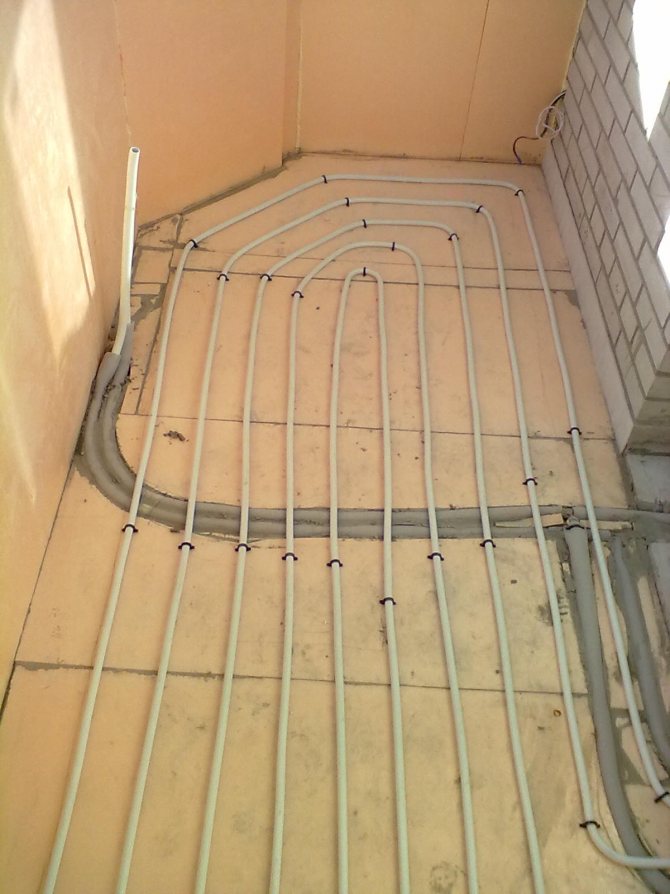

Disadvantages:
- damage to the tube can lead to a flood;
- fragility;
- difficult to connect to the central heating system.
Conclusion: a budget balcony heating system, which makes sense to install in the presence of an economical gas boiler.
Heating the balcony on gas
If you decide to use gas heating for your insulated balcony, we advise you to install a convector. We do not recommend a gas boiler, because it will be costly to heat a small space with it.
The gas convector has many advantages.
The equipment is the best option for the owners of apartments with gas pipelines, since gas is cheaper than electricity. Compact devices effectively heat a small room and consume little fuel. And if the balcony is on the sunny side, the sun will also warm it.
The convector is easy to install and can be connected to a separate gas cylinder. If the BTI allows it (it is considered a redevelopment), it is allowed to connect to the gas network of the building. But here it is easier to get "good", because one hole is required to discharge the exhaust gases into the street. Such manipulations are permitted by the law.
A big plus of the devices is the presence of a gas leakage protection system.
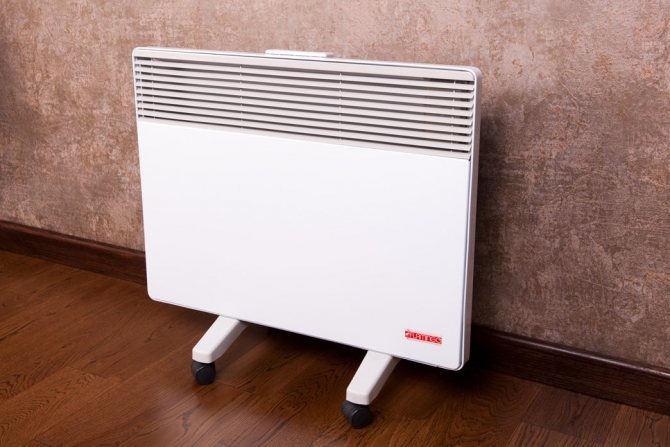

Electric floor heating
Electric heating of a balcony is more expensive and more reliable than water heating. Installation is almost indistinguishable from water systems. The only difference is that the electric floor must be connected to the power supply.
Benefits:
- durability;
- easy installation;
- precise temperature control.
Disadvantages:
- high price;
- needs a stable mains voltage;
Conclusion: a durable system for apartments, small suburban areas.
Electric underfloor heating on the balcony is of two types:
- cable;
- infrared.
The latter type is more modern, but it is not devoid of its shortcomings.
Cable electric heating
The heating element of such a system is a one- or two-core wire that has two layers of insulation. Cable heating on the balcony is not very economical.
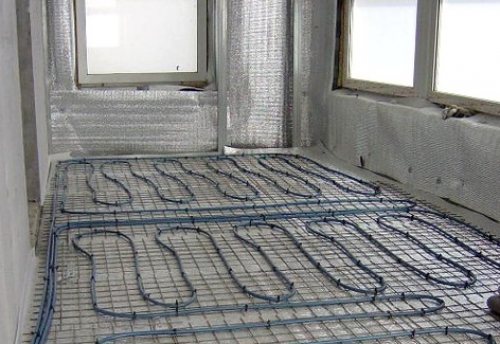

Infrared electric heating
Thin thermal films of infrared heating systems consist of graphite strips isolated from each other and from the environment. Such heating is 20% more economical than cable analogs, completely safe, but its service life is no more than 15 years.
Heating options for the loggia and balcony
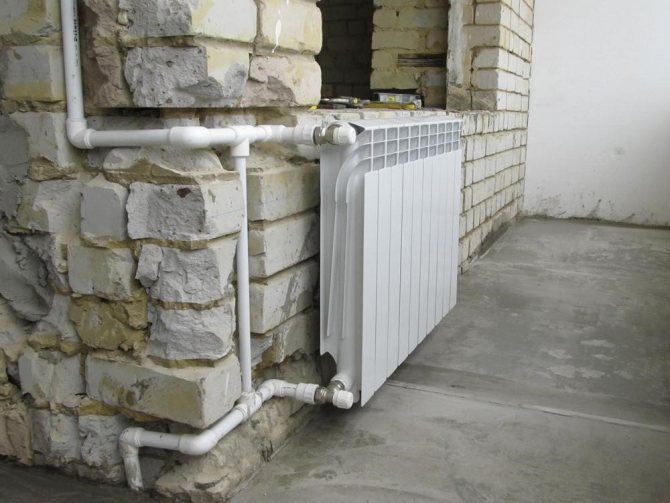

After taking all the measures to reduce heat loss, you can proceed to the installation of a heating system for a balcony or loggia. It can be implemented in several ways, each of which will be discussed below.
From the central


Some high-rise buildings still have a central heating system. Therefore, you can warm up a balcony or loggia using it. It should be understood that this is not the best option. There are several reasons for this:
- increase in heating charges;
- the difficulty of obtaining a permit;
- the need for a large number of documents;
- low efficiency;
- a certain complexity of installation.
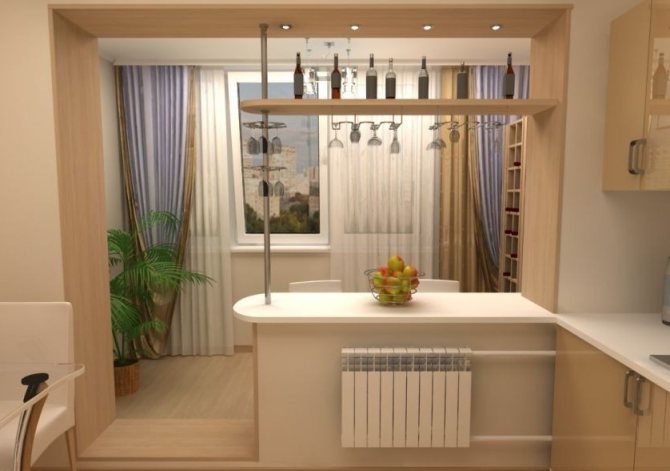

It should be understood that installing a separate radiator on a balcony or loggia from the central heating system is quite problematic. In fact, the tenants of the apartment are not allowed to do this without special permission. The permit is issued at the BTI or the management company. In some cases, this is simply not possible. The reasoning is that the part of the system that will be located on the balcony or loggia is at high risk of depressurization or failure. If an accident occurs on the line and the heating is turned off, then the water inside the system on the balcony may simply freeze.
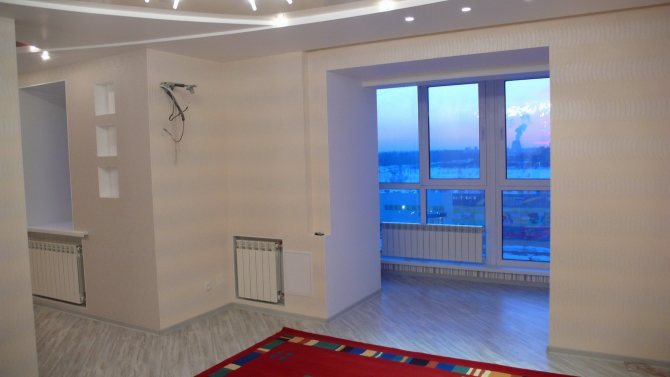

Another argument in favor of refusing to install a radiator from a central heating system to a balcony or loggia is additional heat loss. Since the system is looped and each next floor receives a heat carrier from the previous one, the temperature from which it will go will become much lower, which will not be enough for high-quality heating of apartments.
Advice! Some organizations are ready to issue permission for the installation of a heating radiator from the central system on the loggia if it acts as an adjacent room. To make this possible, it is insulated, as described above, and the glazing between the room and the loggia is removed so that there is free air circulation.
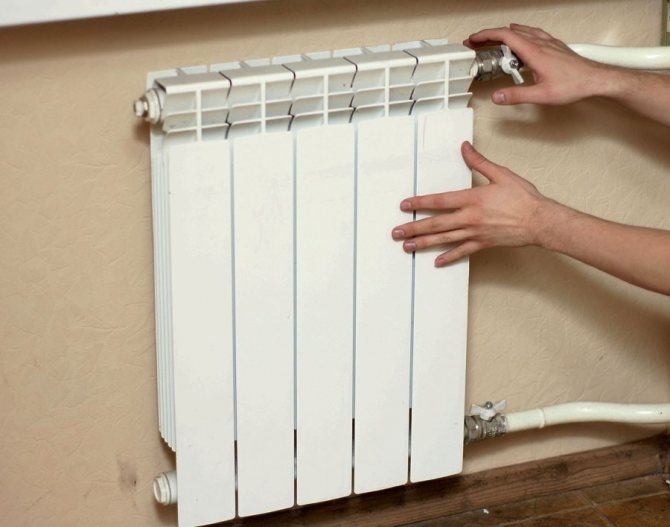

If permission has been obtained, then you can proceed with the installation process. It begins with the preparation of the required equipment. As a radiator for a balcony, which is best suited for a central heating system, you can choose a cast iron or bimetallic battery. To create a thermal barrier on a balcony or loggia, the radiator is mounted directly under their windows. Moreover, it must cover 75% of the entire length of the glazing, since otherwise it will be ineffective. Mounting is done on special brackets.
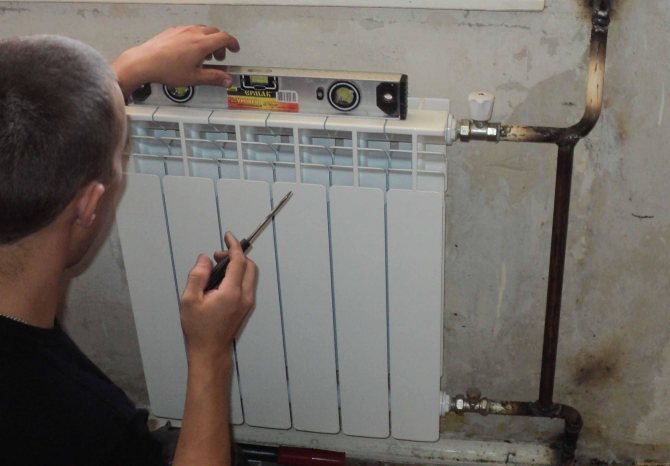

After the radiator has been fixed on the balcony or loggia, you can start supplying pipes through which the coolant will come. They must be additionally insulated with insulation and hidden in the floor or in the wall so that they do not interfere. Mayevsky taps, plugs and valves are installed on radiators. It is important to provide a jumper that will allow the heating system to circulate without obstruction, even if the radiator needs to be replaced. When everything is ready, you can tap into the central system.For this, the riser is overlapped. This procedure will require additional permission from the management company. Due to this peculiarity, it is better to carry out installation work in the warm season, since no one will give such permission in autumn and winter. A video about installing heating on the balcony is below.
Warm floor


Making a warm floor as heating for a balcony or loggia is much more realistic than putting out a radiator on them. This is due to the fact that in new houses a separate riser is provided for connecting a warm floor. In this case, the insulation is carried out in accordance with the requirements, but the floor is left without finishing. After that, waterproofing and insulation are laid on the floor. It is better to choose insulation with beads, which will facilitate the process of laying the pipe. The pipe is installed in accordance with the selected pitch. After that, the screed is poured on the balcony or loggia and the floor is finished. In this case, for the balcony, it is better to choose a tile that has excellent thermal conductivity and will be able to quickly transfer the temperature from the pipes to the air.
Heating with electrical appliances
If you were able to insulate the balcony, but there is not enough time or money to install the heating system, use heaters. Dealing with all the variety of these devices can be tricky. Let's consider each of them in more detail.
Fan heater
A fan heater is an inexpensive option for auxiliary or spot heating in a loggia.
It consists of:
- hulls;
- heating element;
- heat dissipation systems.
The body can be made of plastic or metal. After prolonged use, the plastic may burn and melt in some places. This does not affect the operation of the device, but still you shouldn't spare money to buy a high-quality heater.
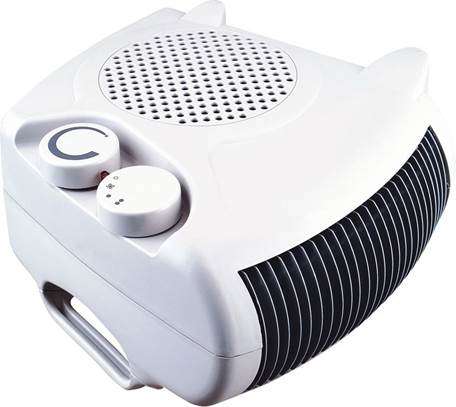

The key part of an electric fan heater is the heating element.
Main types:
- Spiral from nichrome wire. It is used in the cheapest devices. It has a high temperature and very low heat dissipation.
- Tubular heating element. A metal tube filled with a thermally conductive substance. It has average heating and heat transfer rates.
- Ceramic. Semiconductor glass-ceramic sputtered heating element. Has the highest heat transfer parameters.
For a small room, floor-standing stationary or mobile fan heaters in a metal case are suitable.
Convector to the balcony
A convector is a thermal panel, an automatic heater that gradually changes the temperature in the room. Cold air enters the housing, heats up, then blows back out. The heating element does not heat up above 100 degrees, which reduces the likelihood of ignition of surrounding objects to a minimum.
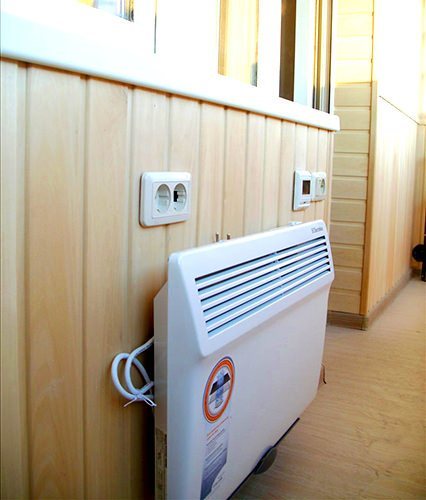

The thermal panel can have the following heaters:
- Electric. Nichrome coil, tubular electric heater, infrared element. Expensive models are distinguished by increased efficiency, reduced energy consumption.
- Gas. Economical, but requires connection to a gas cylinder, central gas pipeline.
A convector heater should be used to maintain a constant temperature on the balcony.
Oil radiator
An oil heater resembles a conventional water battery, but works much more efficiently.
It consists of:
- metal radiator;
- mineral oil with high thermal conductivity;
- tubular electric heater;
- temperature control systems, supplied power.


Radiators are of two types:
- panel;
- sectional.
Always choose a section oil cooler. This design has an increased area of contact with the ambient air. There are mobile, stationary models. Choose equipment depending on the size of the balcony.
How to choose an electric heater suitable for balcony heating
Small apartment owners try to make the most of the available space. The useful space can be increased by insulating the balcony. To do this, it is necessary not only to provide thermal insulation of the room, but also to install a heat source in it. You should choose a heater for a balcony in terms of power, size and design.


What should be a heater for heating a balcony?
The requirements for a balcony heater are related to its type and technical characteristics. However, it is worth considering the features of the room to be insulated.
Why is it needed and where is it used?
If things are stored on the balcony or linen is being dried, there is no need to heat the balcony. Heating is necessary in several cases:
- When storing vegetables or winter preparations. In this case, the high temperature is not needed, but it is necessary to maintain it at the level of +3 - +5 degrees.
- Re-equipment of the balcony into a study, gym or winter garden.
- Combining a loggia with a kitchen or living room. Heating is necessary to maintain the temperature from +20 to +25 degrees.
How it works: device and principle of operation
Various heating devices that can be placed on the balcony work on the principle of convectors or radiators. Convection devices heat the air. The heated masses spread throughout the room, creating a heat cycle.
Infrared heaters do not heat the air, but the objects on the balcony. Then the furniture, floor and walls begin to transfer heat to the air.
Both types of heaters are powered from the electrical network. The current flows through the wires and enters the heating element. The latter either heats up by itself, or creates radiation that can heat objects around.
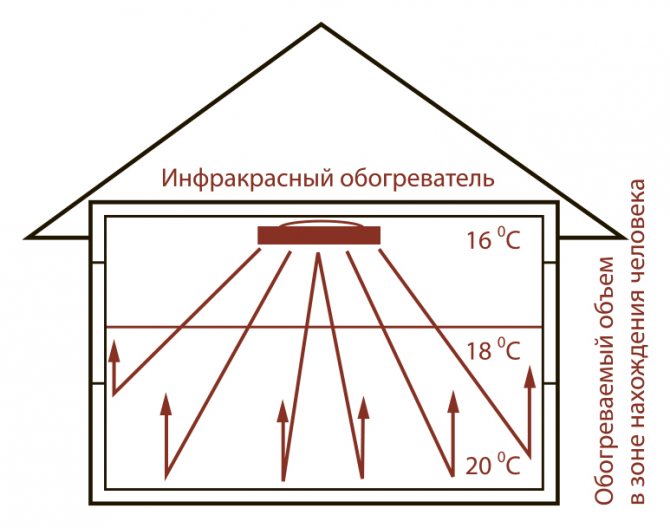

Varieties of devices
There are several main types of heating devices that are chosen for installation on the balcony:
- Fan heater. It can be placed on a windowsill, floor, or small table. The compact device draws in cold air and blows out hot air. A heating element is located in front, and behind it is a fan blowing off heated air masses. A fan heater is often installed on a balcony as an additional source of heat, since it is not designed for constant operation and creates a lot of noise.
- Thermal panel (convector). It runs quietly but produces a lot of heat. It can be left to work around the clock. Modern devices are equipped with an automation system that allows you to maintain a certain temperature in the room. Such devices are often placed on the floor and on the wall. A serious drawback of the device is the significant consumption of electricity.
- Oil heater. It is convenient to move it around the room. The device has a metal case, which contains a heating element and oil. When the oil reaches 80 degrees, the device turns off. It heats up the room slowly, but remains hot for a long time.
- Infrared heater. Such heaters have a high efficiency - up to 98 degrees. The appliance first heats up solid objects. It consumes less electricity than convectors and oil heaters.
Reviews about balcony heaters: pros and cons
Based on user reviews, balcony heaters have the following advantages:
- Mobility. Small-sized heat sources are convenient to move if necessary.
- Easy to use - just plug the device into a power outlet to heat up the room.
- Attractive design - most of the models are made in the form of panels.
The disadvantages of balcony heaters include:
- The need to install the device at a certain distance from the resting place or working area.
- Inconvenience of placing floor models. They take away some of the usable space.
Manufacturers and popular models: rating of the best and prices
Among the popular models of heating appliances for the balcony, the following are worth highlighting.
IR heater Mister Heat Thermik S-0.1


The infrared type device has a power of 100 watts. The maximum surface heating is 60-100 degrees. If overheating, the device turns off. The cost of the model is 1400 rubles.
Wall-mounted monolithic device Nikaten NT 330
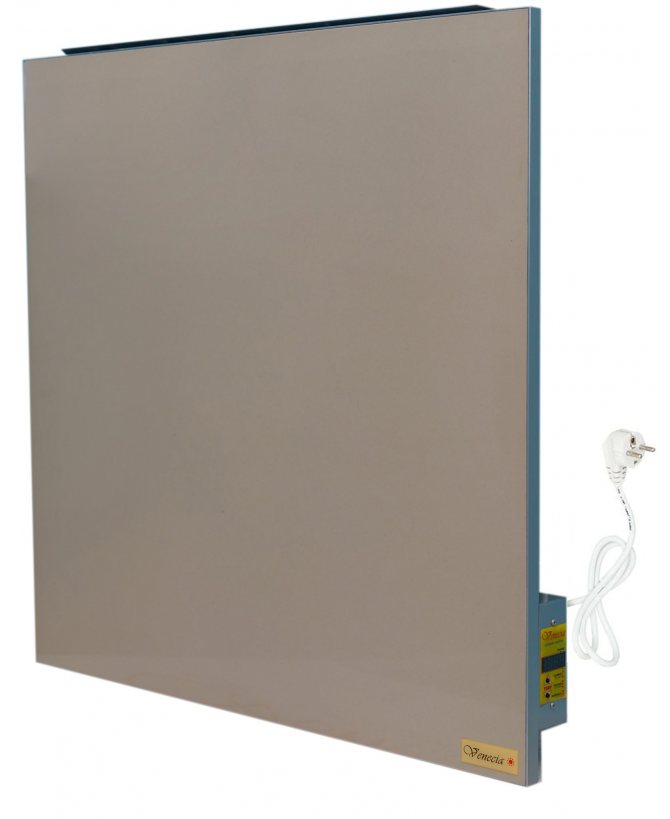

The wall-mounted appliance has a power of 330 W and heats a room up to 7 m2. The price of the device is 4200 rubles.
Teplofon Binar 1.0


The heater on casters has a power of 1000 W and can work efficiently in rooms up to 12 m2. Equipped with electronic control and temperature control function. The cost of the equipment is 6700 rubles.
Noirot Melodie Evolution (low) 750
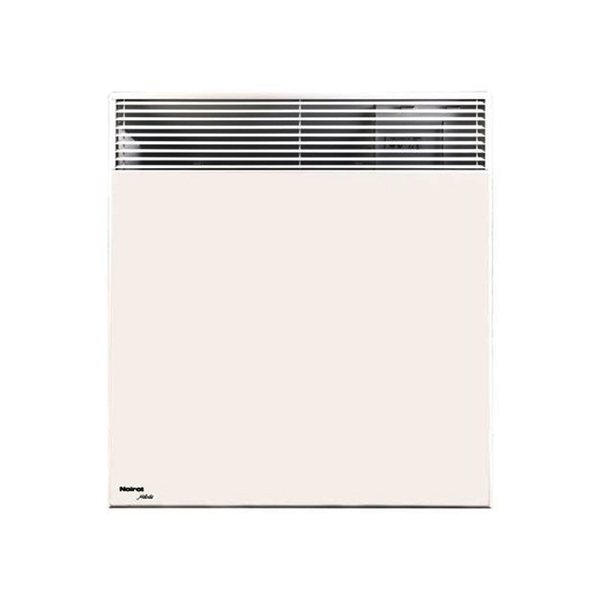

The innovative device works silently and is completely safe in operation (rounded corners and a maximum heating temperature of 60 degrees). Thanks to electronic automation, the device copes with voltage drops of 150-242 V. The heater does not need to be grounded, it can be used in humid rooms. Thanks to the mimetic coating of the body, the device is able to take on the dominant color in the interior. The cost of the equipment is 18 thousand rubles.
Convector Ballu BEC / EZER-1500
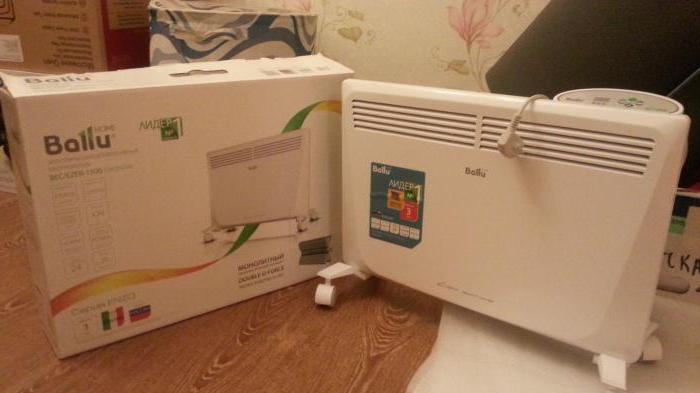

The convector heater, equipped with a power regulation function, successfully heats a room up to 20 m2. It is possible to regulate power modes - 750 or 1500 W. There is a built-in air ionizer. The cost of the device is 3000 rubles.
MEGADOR Light-150


Energy-saving convector capable of heating 10 m2. It is possible to switch the power to 200 or 400 W. The device is equipped with a humidification system. The cost of the heater is 2800 rubles.
Which manufacturer and which type is better to choose: TOP-3
- MEGADOR Light-150. The device effectively heats a balcony up to 10 m2. Thanks to the air humidification system, an optimal microclimate is maintained on the balcony. The cost of the heater is 2800 rubles.
- Noirot Melodie Evolution (low) 750. Convenient and safe heater can work around the clock without wasting much energy. The price of the device is 18 thousand rubles.
- Nikaten NT 330. A wall-mounted device is capable of heating a balcony up to 7 m2. The device costs 4200 rubles.
The minimum required power of the device
To calculate the power of a heater placed on the balcony, you will need to find out the number of cubic meters of space in the room and the level of heat loss. You can use the standard indicators:
- For rooms with a high degree of thermal insulation, 1 m3 requires 20 watts.
- For objects with an average thermal insulation, 30 W / m3 is sufficient.
- Weakly insulated rooms are effectively heated when calculating the device 40 W / m3.
- For objects with a minimum thermal protection, 50 W / m3 will be required.
Thus, when calculating the power of the heater, first determine the number of cubic meters of balcony space, and then multiply it by a suitable coefficient.
For example, with a slightly insulated balcony area of 12 m2 and a ceiling height of 3 m, the calculation is as follows:
12x3x40 = 1440 W
The device should have such a performance so that it can effectively heat the room. You can reduce the required indicator by insulating the balcony.
What else to consider when choosing a device?
When choosing a heater for winter heating of a balcony, the peculiarities of the operation of the room are taken into account. Intermittent heating requires rapid heating, but long heat retention is not required. A simple fan heater can be used for this purpose.
Constant heating is created by all other options. When using an oil radiator, it is possible to ensure uniform heating of the loggia, avoiding sudden temperature fluctuations. The convector is able to evenly distribute warm air throughout the room. When choosing energy-saving heating, it is better to pay attention to infrared models.
3 best models
Among the above, it is worth highlighting the best models:
- MEGADOR Light-150.The device effectively heats a balcony up to 10 m2. Thanks to the air humidification system, an optimal microclimate is maintained on the balcony. The cost of the heater is 2800 rubles.
- Noirot Melodie Evolution (low) 750. Convenient and safe heater can work around the clock without wasting much energy. The price of the device is 18 thousand rubles.
- Nikaten NT 330. A wall-mounted device is capable of heating a balcony up to 7 m2. The device costs 4200 rubles.




Most buyers speak positively about the presented models.
Cost
The price of heaters depends on the power and heating area, the design of the device and the type of installation, the control features and the type of heating elements:
- oil heaters cost from 1,500 to 6,000 rubles;
- the cost of convectors varies from 2 to 20 thousand rubles;
- infrared models suitable for heating a balcony cost from 1 to 7 thousand rubles.
When choosing a device that is suitable for the price, it is worth considering the degree of insulation of the balcony.
Where to buy a heater for the balcony?
Popular stores offer a variety of convectors, oil heaters and infrared models. It is worth figuring out where you can buy a device for heating a balcony in Moscow and St. Petersburg.
In Moscow
There are many retail outlets in the capital:
- "Ariklimat". One of the points of delivery of goods is located at Moscow, st. Electrozavodskaya, 24, st. m. Electrozavodskaya. Store phone number.
- LLC "Termomir". Store address - Moscow, st. Dnepropetrovskaya, 14, metro Prazhskaya. Telephone .
- City Climate. Moscow, st. Electrozavodskaya, 24, m. Electrozavodskaya, Preobrazhenskaya square. Phone - 8 (495) 989-87-36
By purchasing a balcony heater from these stores, the buyer receives reliable and durable equipment.
In St. Petersburg
In the northern capital, you can buy a heater in the following companies:
- "Engineer-climate". The store is located at the address - St. Petersburg, st. Smolenskaya, 33 BC "Smolensky", office 204. You can contact the manager by phone.
- Shop "Buran". Located at st. Zheleznovodskaya, 3, lit. A (1st floor), section 8. Telephone .
- LLC Shop L 178. Addresses of points of issue - st. m. Prospect Enlightenment, Engels ave. 139; Art. m. Leninsky Prospekt, Leninsky Prospekt, 129 k6. Telephone for communication with clients - 7 (812) 438-09-19.
You can buy a balcony heater at most major hardware stores. Before choosing a specific model, it is worth calculating the required power of the device. for this, the degree of insulation of the room and its size are taken into account.
May 17, 2018T C



